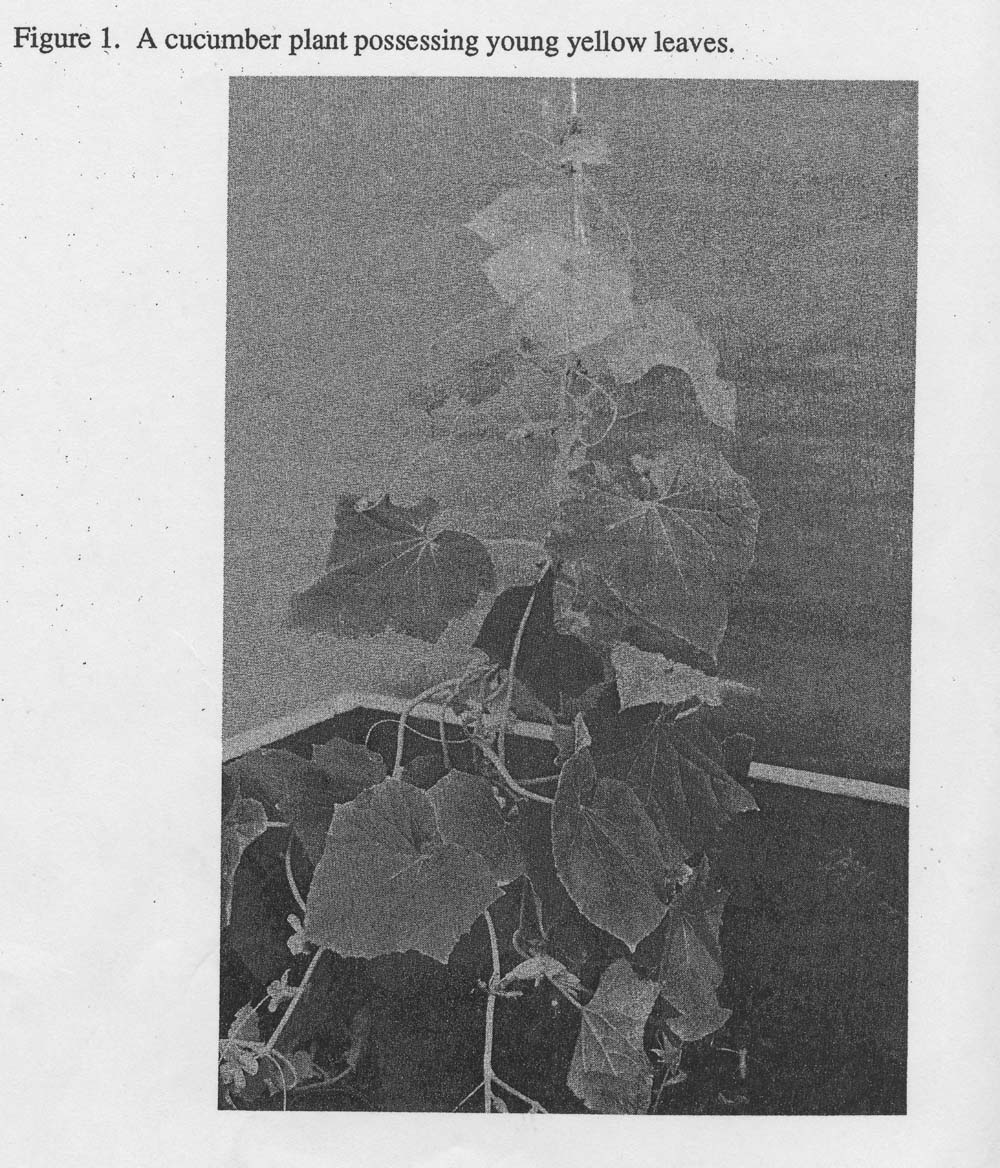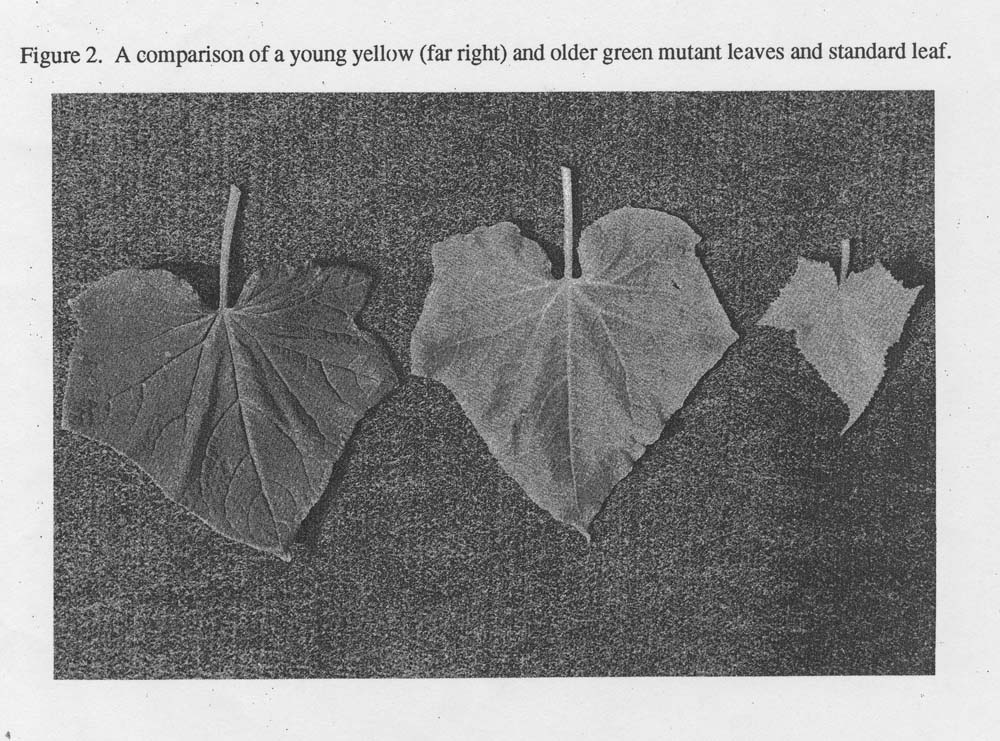Cucurbit Genetics Cooperative Report 17:21-23 (article 6) 1994
M. Rucipska, K. Neimirowicz-Szczytt and A. Korzeniewska
Department of Genetics and Horticultural Plant Breeding, Warsaw Agriculture University – SGGW, 02-766 Warsaw, Poland
Our collection of chemicaly induced cucumber mutants presented hitherto in the Cucurbit Genetics Cooperative (CGC) Report and in the proceedings of the 9192 Eucarpia Cucurbitaceae meeting includes a mutant with yellow stem and leaf petiole (Rucipska et al., 1992a), short petiole (Rucipska et al., 1992b), and dividd and ginko leaves (Rucipska et al., 1992c). We would like to add a new mutant to the series, namely, yellow young leaves and stem. As with previous mutants, this mutant was obtained by Dr. B. Kubicki some twenty years ago and was maintained by self-pollination.
Methods. In order to determine the inheritance of young yellow leaves, a standard genetic analysis was made. Amongthe generations analyzed was a Mutant x B (Borszczagowski inbred line) combination. This cross was made becauseof the difficulties of obtaining viable seeds.
Results. The young yellow leaves of a stem mutant can be distinguished at the cotyledon and first leaf stage. Cotyledons are yellow and green, andthe first leaf is yellow. The growth of mutant plants depends upon the intensity of light during growth (i.e., the less intensive the light, the better the plant growth). For instance, a few cloudy days in the spring are enough to change the young yelow mutant plants to green. Intensive sunlight gradualy causes some mutant plants to become yellow to white-yellow. Mutant plants remain viable because their older leaves (nearly half of the plant) are green. Usualy, mutant plants are smaller than the standard type (B line from which they were induced) and posess less abundant female flowers (seeds). Pollen stainability is between 50 to 90%, and thus it is difficult to cross mutant plants with other “normal” plants. Genetic analysis of the mutant indicates that the trait of youngyellow leaves is governed by one recessive gene, which we propose to designate yl.
In the list of cucumber genes (Pierce and Wehner, 1989), as well as in the latest issues of CGC, there were numerous descriptions of chlorophyll deficient mutants. Some of the presentations were very short and incomplete. For cotyledon mutants (Iida and Amano, 1991), it was impossible to determine whether or not any of the mutants are identical with the one we now present in thispaper. We provide the first description of the young yellow leaf mutant and its genetic analysis. The data presented in Table 1 confirms the recessive character of the gene.
The chloroplast ultrastructure of the mutant was studied and described presviously (Paldzewska et al., 1983). It was found that in yellow leaves there were plastids with a carying degree of defective characteristics(i.e., reduction and disorganization of the thylakoid system). Normal chloroplasts were also observed. The character of young yellow leaves was precisely determined from morph9ological and cytological observation, and can be used for further genetic and physiological investigations (e.g., those related to light intensity).
Table 1. Inheritance of Young Yellow Leaves (yl) in cucumber.
| No. observed | No. expected | Ratio | |||||
| Generation | Normal | Mutant | Normal | Mutant | tested | X2 | P value |
| P1 (normal | 42 | 0 | 42 | 0 | 1:0 | — | — |
| P2 | 0 | 42 | 0 | 42 | 0:1 | — | — |
| (mutatant) | |||||||
| F1 | 40 | 0 | 40 | 0 | 1:0 | — | — |
| F2 | 185 | 61 | 184.5 | 61.5 | 3:1 | 0.005 | 0.005 |
| F1 x P1 | 170 | 0 | 170 | 0 | 1:0 | — | — |
| F1 x P2 | 87 | 77 | 82 | 82 | 1:1 | 0.610 | 0.05 |
Figure 1. A cucumber plant posessing young yellow leaves.

Figure 2. A comparison of a young yellow (far right) and older green mutant leaves and standard leaf.

Literature Cited
- Iida, S. and E, Amano. 1991/ Mutants induced by pollen irradiation in cucumber. Cucurbit Genet. Coop. Rpt. 14:32-33.
- Pierce, L.K. and T.C. Wehner. 1989. Gene list of cucumber. Cucurbit Genet. Coop. Rpt. 12:91-103.
- Palczewska, I., B. Gabara, E. Mikulska and B. Kubicki. 1983. chloroplast ultrastructure in leaves of Cucumis sativus chlorophyll mutant. Acta Soc. Bot. Pol. 52:131-137.
- Ruciska M. K. Niemirowcz-Szcytt and A. Korzeniewska. 1992a. Cucumber (Cucumis sativus L.) mutant with yellow stem and leave petioles. Cucurbit Gene. Coop. Rpt. 14:9-9.
- Rucipska M., K. Niemirowcz-Szcytt and A. Korzeniewska. 1992b. Cucumber (Cucumis sativus L.) induced mutations II. A second short petiole mutant. Cucurbit Genet. Coop. Rpt. 15:33-34.
- Rucipska M., K. Niemirowcz-Szcytt and A. Korzeniewska. 1992c. Cucumber (Cucumis sativus L.) induced mutations III and IV. Divided and Ginko leaves. p. 66-69. In: Proc. Fifth Eucarpia Cucurbitaceae Symposium, Poland. July 27-31, 1992.